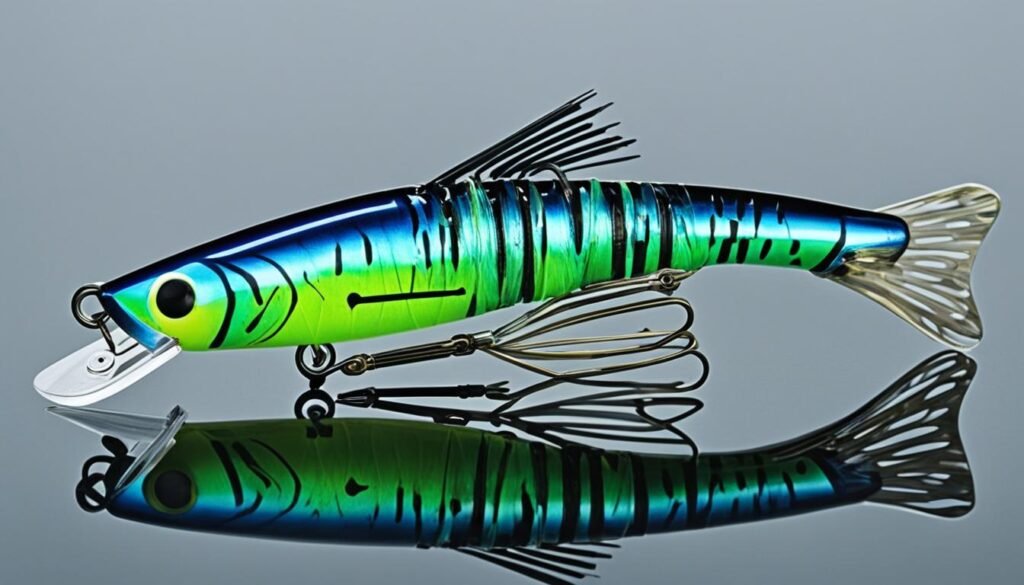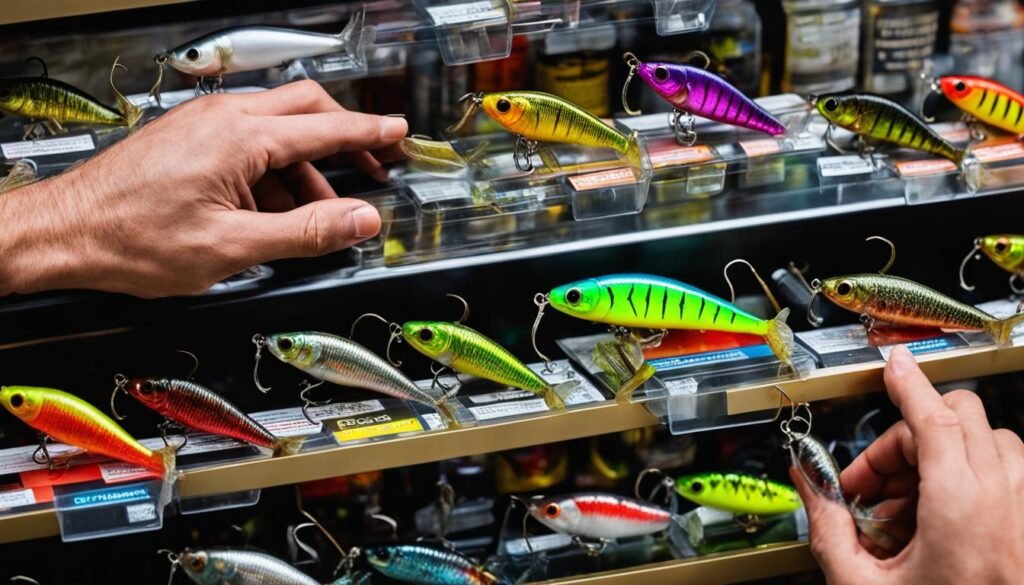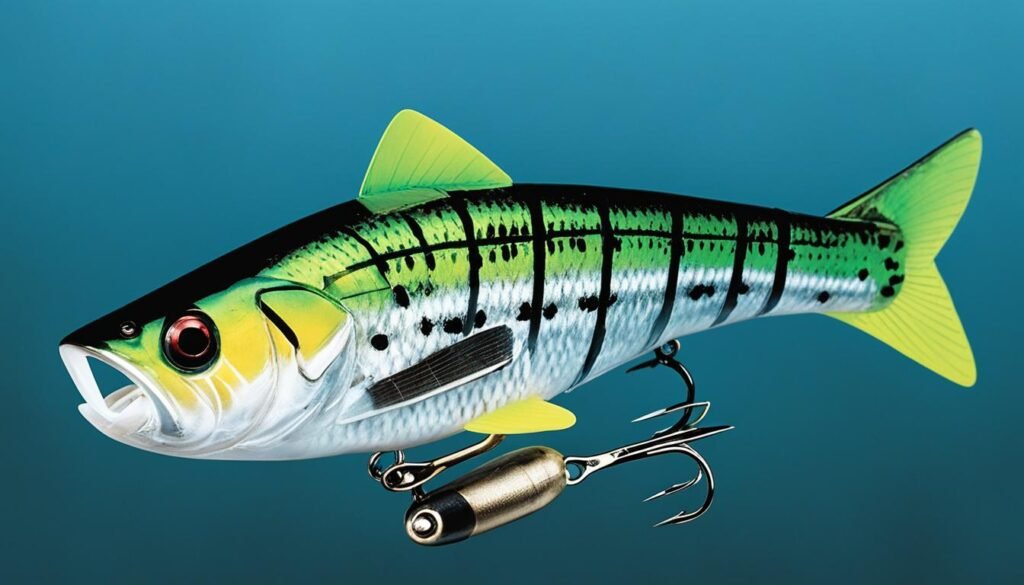So, what exactly are glide baits? Well, they are fishing lures specifically designed to mimic the natural movement of prey in the water. These lures are known for their ability to entice even the most finicky bass, making them a favorite among freshwater fishing enthusiasts. With their realistic action and enticing appearance, glide baits have become a go-to choice for anglers looking to hook into some impressive catches.

Glide Baits: What Exactly Are They?
Welcome to the world of glide baits! If you’re new to fishing or looking to expand your lure collection, glide baits are a must-have in your tackle box. In this section, we will provide an introduction to glide baits and explore their unique features and benefits.
What are Glide Baits?
Glide baits are a type of fishing lure designed to mimic the movement of injured or fleeing prey. These lures are known for their seductive side-to-side gliding action, which elicits predatory instincts in fish, particularly bass. Unlike traditional lures that rely on constant reeling, glide baits provide a realistic presentation that can entice even the most stubborn bass out of hiding.
Types and Variations
There are various types and variations of glide baits available on the market, each with its own unique characteristics and applications. Some common types include topwater glide baits, which are designed to float on the water’s surface, and subsurface glide baits, which dive below the surface. Additionally, glide baits come in different sizes, shapes, and colors to mimic specific prey species and match various fishing conditions. Whether you prefer large, realistic swimbaits or smaller, more versatile options, there is a glide bait to suit every angler’s preferences and fishing style.
Understanding How Glide Baits Work

In this section, we will explore the mechanics behind the movement of glide baits and how they effectively attract and trigger strikes from bass. By understanding how glide baits work, you can enhance your fishing techniques and increase your chances of success on the water.
Mechanics Behind the Movement
Glide baits are designed to create a realistic gliding action in the water, mimicking the movement of injured or fleeing prey. This unique action is achieved through a combination of factors, including the lure’s weight distribution, shape, and design. When retrieved, glide baits move laterally from side to side, imitating the natural movement of baitfish and enticing bass to strike.
Mimicking Prey Behavior
One of the key advantages of glide baits is their ability to mimic the behavior of natural prey. By manipulating the retrieve, anglers can imitate injured or fleeing baitfish, triggering a predatory response from bass. Angling techniques such as pausing, twitching, and varying the speed of the retrieve can simulate the erratic movement of prey, making glide baits irresistible to bass.
Selecting the Right Glide Bait

Selecting the right glide bait is crucial for maximizing your success in bass fishing. There are several key factors to consider when choosing a glide bait that will entice and attract bass effectively. By taking into account these factors, you can increase your chances of landing that trophy catch.
Factors to Consider
When selecting a glide bait, it’s important to consider the size, color, and action of the lure. The size of the bait should match the size of the prey that the bass are feeding on in the specific fishing location. Larger baits are generally more suitable for targeting bigger, more aggressive bass, while smaller baits are better for finesse presentations.
The color of the bait should replicate the natural prey found in the water you are fishing. Matching the color to the forage in the area can make the bait appear more realistic and increase its chances of being perceived as food by the bass.
The action of the glide bait refers to its movement in the water. Some glide baits have a subtle, gliding action, while others have a more erratic or aggressive action. The choice of action will depend on the behavior of the bass in that particular fishing spot and the type of presentation you want to achieve.
Matching Bait to Conditions
Another important consideration when choosing a glide bait is to match it to the fishing conditions. Factors such as water clarity, weather, and the behavior of the bass can influence the effectiveness of a particular bait.
In clear water conditions, smaller and more natural-colored glide baits tend to work best. The increased visibility in clear water allows the bass to closely inspect the bait, so a realistic presentation can be more successful.
In murky or stained water, larger and darker-colored glide baits can create more contrast and attract the bass’s attention. The bigger profile and bolder colors can help bass locate the bait more easily in less ideal visibility.
Additionally, consider the weather conditions and the behavior of the bass. During bright and sunny days, bass may be more active and aggressive, so choosing a bait with a more erratic action can trigger more strikes. On overcast or calm days, a more subtle and natural gliding action may be more effective.
Glide Bait Recommendations
TRUSCEND Lifelike Swimbait

6th Sense Speed Glide 100

TRUSCEND Lifelike Swimbait

6th Sense Flow Glider 130

DISCLAIMER: The links I mention may be affiliate links. If you purchase through one of these links I may receive a commission, at no cost to you. As an Amazon Associate I earn from qualifying purchases.
Techniques and Retrieval Methods

Mastering the right techniques and retrieval methods is crucial when using glide baits for bass fishing. Different approaches can yield varying results, so it’s essential to understand the nuances of each technique and how to adapt them to different fishing conditions. In this section, we will explore the key techniques and retrieval methods for effectively using glide baits to attract and catch bass.
Topwater vs. Subsurface
One important decision to make when using glide baits is whether to fish them on the surface or subsurface. Topwater glide baits create an enticing commotion on the water’s surface, imitating the movements of struggling prey. This technique can be highly effective, especially in calm conditions or when bass are actively feeding near the surface. On the other hand, subsurface glide baits can dive to varying depths and imitate the action of wounded baitfish below the water’s surface. This technique is particularly effective when bass are holding deeper or when there is more movement in the water.
Slow Retrieve vs. Twitching
Another factor to consider when using glide baits is the retrieval speed and technique. A slow, steady retrieve can mimic a wounded or injured baitfish, which can be irresistible to bass. By maintaining a slow retrieve, you allow the glide bait to exhibit its natural side-to-side action, enticing nearby bass to strike. On the other hand, twitching the glide bait can create sudden bursts of movement, imitating the erratic behavior of injured prey. This technique can be effective for triggering reaction strikes from bass that are in a more aggressive feeding mode.
Working Structure and Cover
When using glide baits, it’s important to know how to effectively work them around structure and cover, as bass often seek shelter in these areas. By carefully maneuvering the glide bait near submerged logs, rocks, weeds, or other underwater structure, you can entice bass lurking in these hiding spots to strike. Cast the glide bait near the structure and let it glide and pause, allowing it to tempt any nearby bass. Vary the speed and direction of the retrieve to imitate natural movements and make the bait appear more lifelike.
Where and When to Use Glide Baits

Knowing where and when to use glide baits is crucial for maximizing your success in bass fishing. These versatile lures can be effective in a variety of situations, but understanding their seasonal applications and ideal fishing locations can greatly enhance your chances of hooking into some trophy bass.
Seasonal Applications
The effectiveness of glide baits can vary depending on the time of year and the behavior of the bass. Understanding the seasonal patterns can help you determine the best times to use glide baits. During the spring and fall, when bass are more active and feeding aggressively, glide baits can be highly effective. The slow, gliding action of these lures can entice strikes from bass in both shallow and deeper water. In the summer, when bass tend to be more lethargic in the heat, choosing smaller glide baits and fishing during low light conditions such as early morning or late evening can yield better results. In the winter, when bass are less active and seek deeper water, glide baits can still be effective when fished slowly and near structure where bass may be seeking shelter.
Ideal Fishing Locations
When it comes to glide bait fishing, location is key. Certain types of water bodies and specific areas tend to produce better results when using glide baits. Look for areas with high bass activity, such as points, drop-offs, submerged structures, and areas with abundant cover like vegetation, fallen trees, and docks. Bass are often found around these areas as they provide cover and ambush points for feeding. Additionally, larger bodies of water like lakes and reservoirs tend to offer more opportunities for glide bait fishing, as there is a greater chance of encountering larger bass. Remember to adapt your fishing location based on the prevailing conditions such as water temperature, clarity, and weather patterns to increase your chances of success.
What rod and line do you need?
Choosing the right rod and line is essential for optimal performance when fishing with glide baits. To ensure you have the right setup, consider the following guidelines:
- Rod Selection:
- Length: Choose a longer rod, around 7 to 8 feet, to provide the necessary leverage for casting and controlling the glide bait.
- Action: Look for a rod with a medium-heavy to heavy action. This will provide the stiffness needed to effectively work the lure and set the hook when a bass strikes.
- Material: Graphite or graphite composite rods are popular choices for glide bait fishing due to their sensitivity and strength. However, fiberglass rods can also work well, especially for larger glide baits.
- Reel Selection:
- Gearing Ratio: Choose a reel with a slower gear ratio, around 5.4:1 to 6.4:1, as this allows for a steady and controlled retrieve, enhancing the gliding action of the bait.
- Line Capacity: Choose a reel with an appropriate line capacity, typically in the range of 10 to 14 pounds for monofilament or fluorocarbon lines. If you prefer using braided line, consider a higher line capacity to accommodate its smaller diameter.
- Drag System: Look for a reel with a smooth and reliable drag system to handle the powerful runs and sudden bursts of energy from bass.
- Line Selection:
- Fluorocarbon: Fluorocarbon line is a popular choice for glide bait fishing due to its low visibility, sinking properties, and excellent sensitivity. Choose a line with a suitable pound test based on the size of the glide bait and the target bass species.
- Monofilament: Monofilament line can also be a good option, offering a balance of strength and flexibility. It provides good knot strength and buoyancy for topwater presentations.
- Braided: Braided line can be used as a mainline for glide bait fishing, especially if you need the extra strength and abrasion resistance. However, it is recommended to use a fluorocarbon or monofilament leader to minimize line visibility.
Tips for Successful Glide Bait Fishing
When it comes to glide bait fishing, there are a few tips and techniques that can greatly increase your chances of success. Reading water patterns is key to identifying the best fishing spots. Pay attention to the movement of the water, such as current breaks, structure, and areas of higher fish activity. These patterns can help you determine where bass are likely to be and where to cast your glide bait for optimal results.
Another important aspect of successful glide bait fishing is modifying baits to increase their effectiveness. Experiment with different colors, sizes, and actions to see what triggers the most strikes. You can also consider adding custom hooks or changing the weight distribution of the bait to achieve the desired action. By constantly tweaking and adapting your glide baits, you can find the perfect combination that entices bass to bite.
Lastly, it’s essential to have a mindset of patience and persistence when fishing with glide baits. These lures are designed to mimic the behavior of natural prey, and bass may take their time before committing to a strike. It may require several casts and retrieves before you get a bite, but don’t get discouraged. Stay focused, stay patient, and keep casting. The payoff can be well worth the wait!
Maintenance and Storage
Proper maintenance and storage are crucial for keeping your glide baits in optimal condition and ensuring their longevity. By following a few simple cleaning and care tips, as well as adopting proper storage practices, you can protect your lures from damage and maintain their effectiveness on the water.
Cleaning and Care Tips
To prevent damage to your glide baits and prolong their lifespan, it’s important to clean them regularly. After each fishing trip, rinse your lures with freshwater to remove any salt, dirt, or debris that may have accumulated. Use a soft cloth or sponge to gently wipe down the surface, paying close attention to any hooks or joints. Avoid using harsh chemicals or abrasive materials that could scratch or corrode the finish of your glide baits.
In addition to cleaning, it’s also essential to inspect your glide baits for any signs of wear or damage. Check the hooks for sharpness and replace any that are dull or rusty. Examine the joints and connections to ensure they are secure and functioning properly. Taking these proactive steps will help maintain the overall performance and effectiveness of your glide baits.
Proper Storage Practices
When it comes to storing your glide baits, it’s important to protect them from environmental factors that can cause damage. To prevent tangling and ensure the integrity of the lure’s action, store each glide bait separately in its own compartment or individual container. This will prevent hooks from becoming entangled and damaging the lure’s finish.
Consider using tackle trays or boxes specifically designed for lure storage, with adjustable compartments to accommodate different sizes and shapes of glide baits. This will help keep your lures organized and easily accessible for your next fishing trip. Additionally, storing your glide baits in a cool, dry place away from direct sunlight will help maintain their color, finish, and overall performance.
Hlotmeky Bead Organizer

Flambeau Outdoors Classic Tackle Box

KastKing HyperSeal Waterproof Tackle Box

Looking For More Bass Fishing Lures and Baits
Check out our other articles on the best lures and baits available and guides on how to use them
